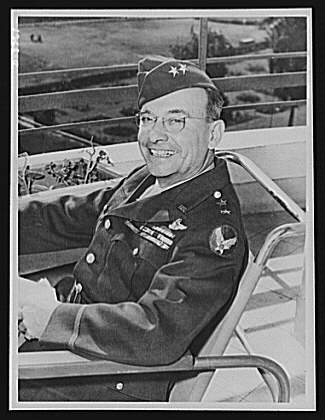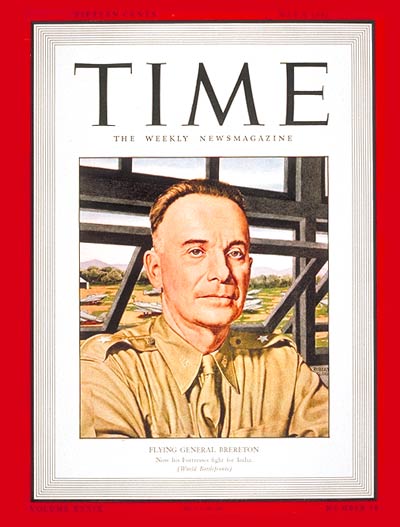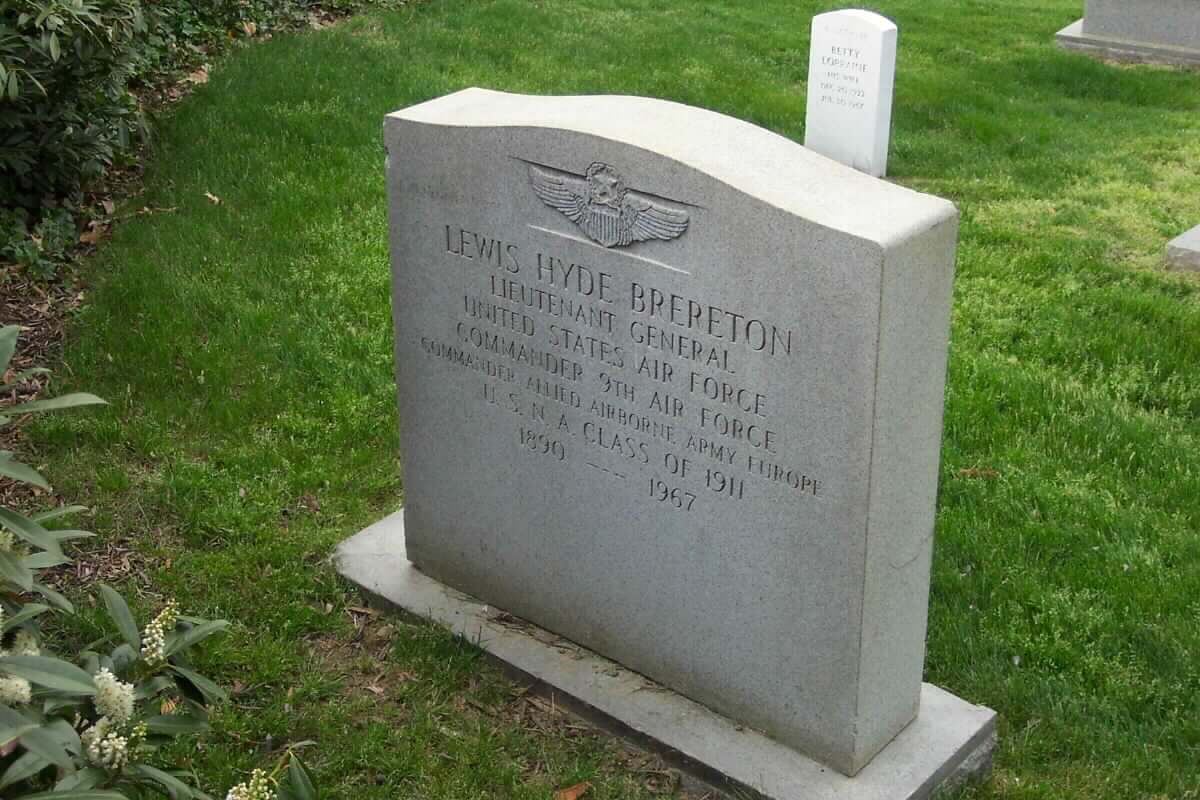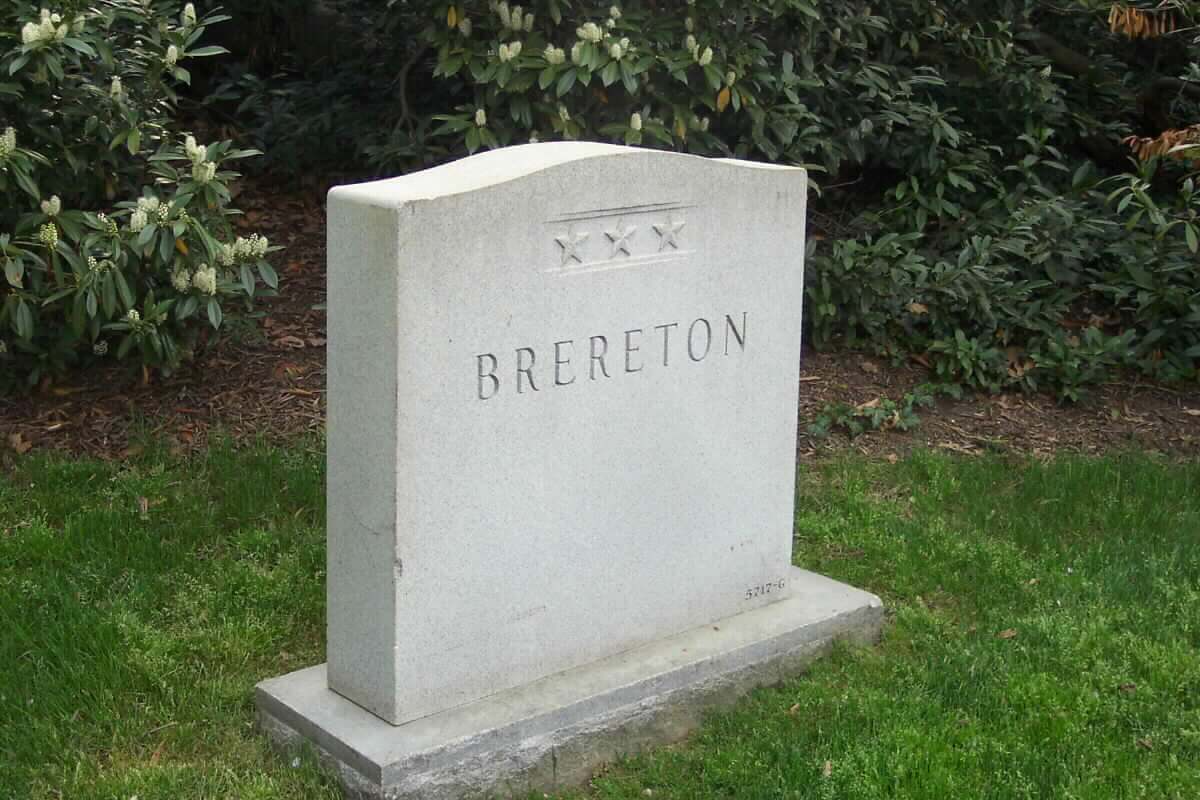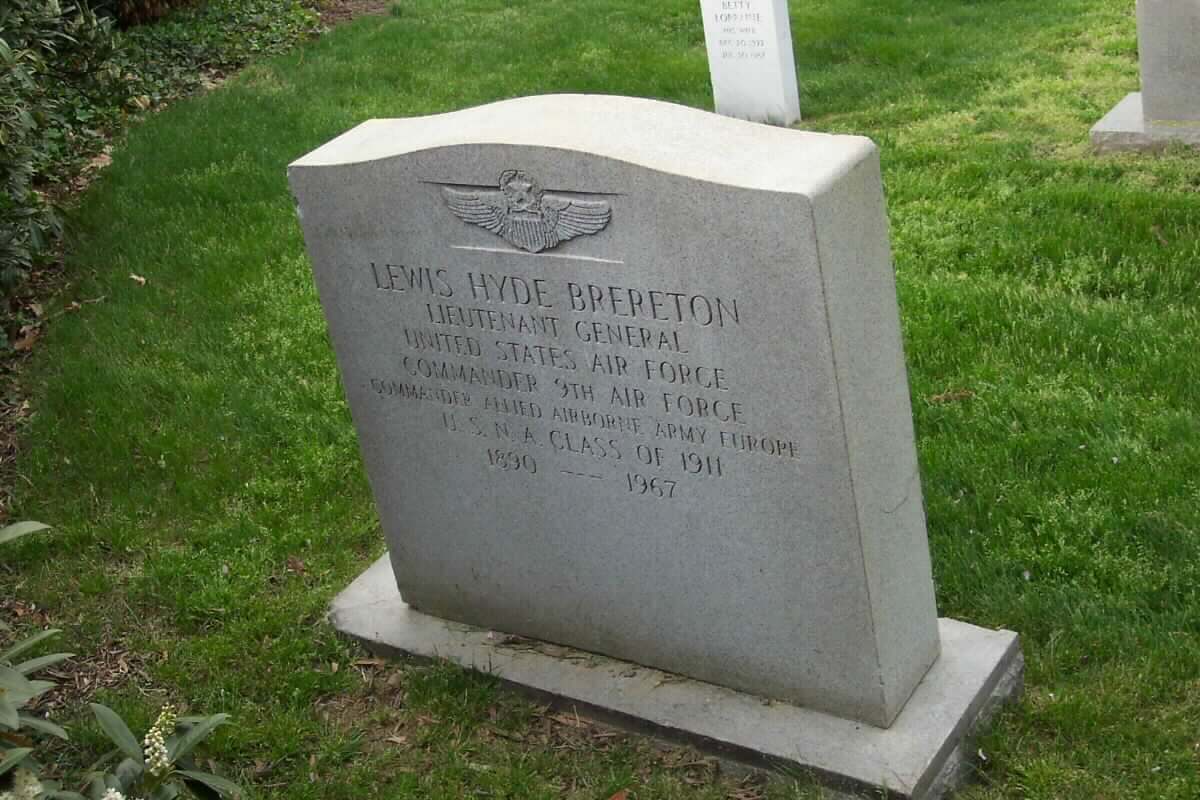LIEUTENANT GENERAL LEWIS H. BRERETON
Retired Sept. 1, 1948, Died August 1, 1967
Lewis Hyde Brereton was born in Pittsburgh, Pennsylvania, in 1890. He attended St. John’s College, Annapolis, Maryland; entered the U.S. Naval Academy in 1907, and graduated in June 1911. He resigned as an ensign, and was appointed a second lieutenant in the Coast Artillery Corps of the Regular Army on August 17, 1911.
After a year’s service in the Coast Artillery Corps, he was detailed in September 1912 to the Aviation Section, Signal Corps, and received flying training at the Signal Corps Aviation School at San Diego, California, qualifying as a military aviator on March 27, 1913. In July 1916, he was transferred to the Second Field Artillery, while serving in the Philippines. He was re-detailed to the Signal Corps, and assigned to duty with the Second Aero Squadron in the Philippine Islands in January 1917.
Returning to the United States in March 1917, he was assigned to duty in Washington, D.C., in the Office of the Aviation Section as chief signal officer.
He went overseas in October 1917, and the following March was placed in command of the 12th Aero Squadron, one of the first American flying units on the front. During this time he carried out extensive operations in both the Toul and Luneville sectors. He took part in the attack at Vaux in July 1918, and on July 5 became chief of aviation, First Army Corps. He took command of the Corps Observation Wing immediately preceding the St. Mihiel operations, and in October 1918, became operations officer on the staff of the chief of Air Service of the American Expeditionary Forces. He continued in this capacity until the cessation of hostilities, when he was appointed chief of staff, Headquarters Air Service of the Third Army.
Upon his return to the United States in February 1919, he was on duty in the Office of the Director of Air Service in Washington as chief of the Operations Division, Training and Operations Group, until December 1919, when he returned to France for duty as air attache at the American Embassy in Paris. In August 1922, he was assigned to Kelly Field, Texas, where he served successively as commanding officer of the Tenth School Group; assistant commandant of the Advanced Flying School; director of attack training, and president of the board on attack aviation.
In September 1924, he assumed his duties as instructor at the Air Corps Tactical School at Langley Field, Va., and in June of the following year became commanding officer of the Second Bombardment Group at Langley Field. In August 1927 he entered the Command and General Staff School at Fort Leavenworth, Kansas, from which he graduated the following June. He was then appointed commanding officer of the 88th Observation Squadron at Post Field, Fort Sill, Oklahoma, and Air Service instructor at the Field Artillery School.
Ordered to duty in Panama in August 1931, he became commanding officer of France Field and the Sixth Composite Group, commanding officer of the Panama Air Depot and air officer of the Panama Canal Department successively. In July 1935, he became an instructor at the Command and General Staff School at Fort Leavenworth, Kansas, and served as such until June 1959. From July 1939 to October 1940, he was on duty at Barksdale Field, Louisiana, as base commander, and then was assigned to command the 17th Bombardment Wing, General Headquarters Air Force, with station at Savannah, Georgia. In July 1941, he was assigned to command the Third Air Force at Tampa, Florida.
Upon the outbreak of World War II, he commanded the Far East Air Force in the Philippines Islands. In January 1942, he was designated air commander-in-chief of the Allied Air Forces on the staff of General Wavell, with station in Java, in addition to his duties as commander of the Fifth Air Force. He organized and commanded the Tenth Air Force in India in March 1942. In June he was designated commander of the Middle East Air Force, later designated the Ninth Air Force. He assumed command of the U.S. Army Forces in the Middle East in February 1945, in addition to his other duties. In October 1943, he relinquished this command serving thereafter as commanding general of the Ninth Air Force in the European theater of operations. In August 1944, he was assigned to command the First Allied Airborne Army and served in the European theater of operations until the capitulation of Germany in May 1945.
He then returned to the United States for assignment to Air Force headquarters at Washington, and in July 1945, was assigned to command the Third Air Force at Tampa, Florida. In January 1946, he was named commanding general of the First Air Force at Mitchel Field, New York. The following month he was assigned to the Office of the Secretary of War at Washington. In July 1947, he was relieved from duty with the Office of the Secretary of War, and assigned to the Military Liaison Committee of the Atomic Energy Commission in Washington.
He returned to Air Force headquarters in June 1948, to become secretary general of the Air Board.
For conspicuous overseas service in World War I, he was awarded the Distinguished Service Cross and the Purple Heart. He received the Croix de Guerre with two palms from the French Government, which further rewarded him by making him an Officer of the Legion of Honor. Other honors conferred upon him were Commander, First Class, Order of Danilo I, awarded by the Montenogrin Government, and the award of Chevalier, Order of Albert of Belgium; the Victor Medal with six stars, Army of Occupation.
During World War II, he was awarded the Distinguished Service Medal with oak leaf cluster, the Legion of Merit with oak leaf cluster, the Silver Star, the Distinguished Flying Cross, the Air Medal and the Bronze Star Medal.
His World War II foreign decorations include the Order of Orange and Nassau Commander Cross by the Netherlands Government (December 1942); the Order of Companion of the Bath by the British Government (June 1942); the Legion of Honor, Rank of Commander, and Croix de Guerre with Palm by the French Government (January 1945); and the Order of Polonia Restituta Commander Cross with Star by the Polish Government (May 1945).
A 1911 graduate of the Naval Academy, when Japan attacked in the Pacific in December 1941, he was commander of U.S. Far East Air Forces, based in the Philippines. What had been described as a breakdown in communications with MacArthur’s Headquarters enabled the enemy to catch Brereton’s Luzon-based B-17s on the ground and the bulk of his force was destroyed.
After serving in the defense of the Philippines, he assumed command of the Middle East Air Forces, which later became the 9th Air Force. Acheiving the rank of Lieutenant General in April 1944, he commanded the 9th when it raided Ploesti, Rummania, and remained with it until August 1944, at which time he took over the 1st Allied Airborne Army.
He is buried in Section 7 of Arlington National Cemetery.
BRERETON, LEWIS HYDE
Major (Air Service), U.S. Army
Pilot, Corps Observation Wing, Air Service, A.E.F.
Date of Action: September 12, 1918
General Orders No. 15, W.D., 1919
Citation:
The Distinguished Service Cross is presented to Lewis Hyde Brereton, Major (Air Service), U.S. Army, for extraordinary heroism in action over Thiaucourt, France, September 12, 1918.
Major Brereton, together with an observer, voluntarily and pursuant to a request for special mission, left his airdrome, crossed the enemy lines over Lironville, and proceeded to Thiaucourt. In spite of poor visibility, which forced them to fly at a very low altitude, and in spite of intense and accurate antiaircraft fire they maintained their flight along their course and obtained valuable information. Over Thiaucourt they were suddenly attacked by four enemy monoplane Fokkers. Maneuvering his machine so that is observer could obtain a good field of fire, he entered into combat. His observer’s guns becoming jammed, he withdrew until the jam was cleared, when he returned to the combat. His observer then becoming wounded, he coolly made a landing within friendly lines, although followed down by the enemy to within 25 meters of the ground. By this act he made himself an inspiration and example to all the members of his command.
Air Force General poses for photographer. Major General Lewis H. Brereton, commanding officer of the
U.S. Army Air Force in the Middle East, takes time out to smile for a photographer (Library of Congress)
Michael Robert Patterson was born in Arlington and is the son of a former officer of the US Army. So it was no wonder that sooner or later his interests drew him to American history and especially to American military history. Many of his articles can be found on renowned portals like the New York Times, Washingtonpost or Wikipedia.
Reviewed by: Michael Howard


